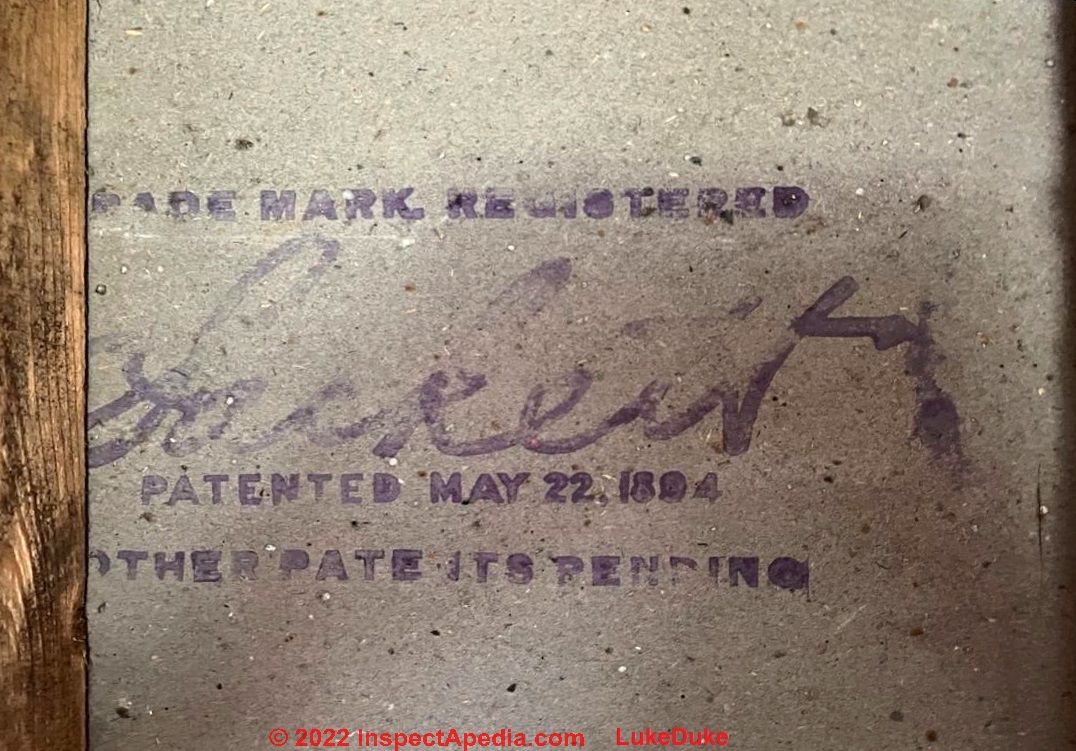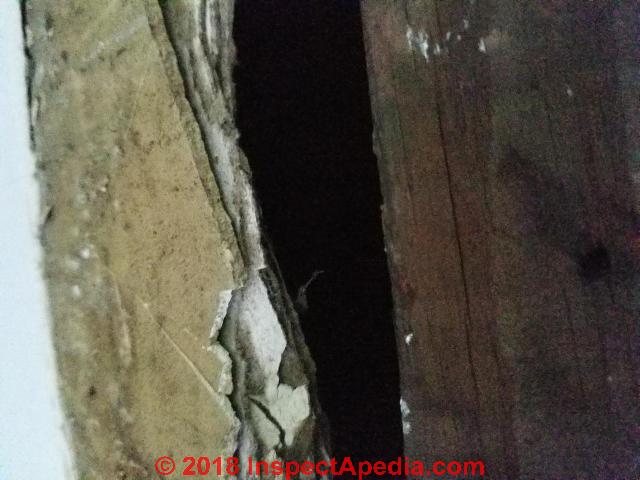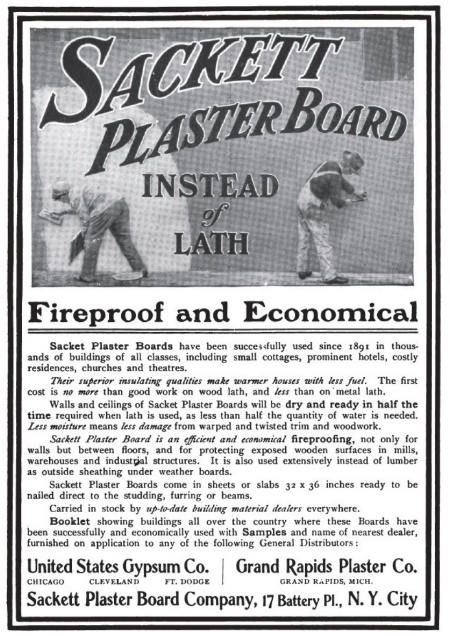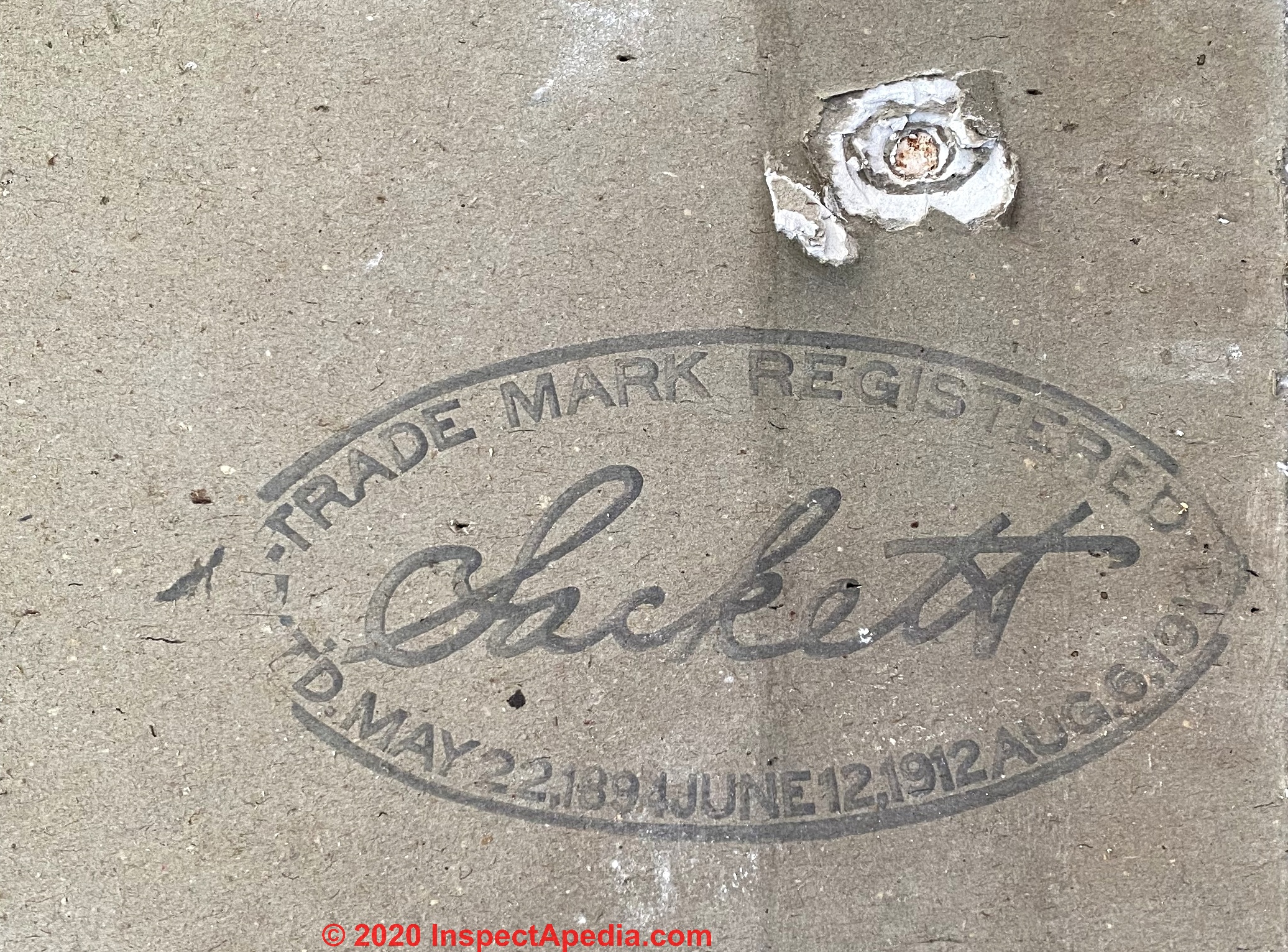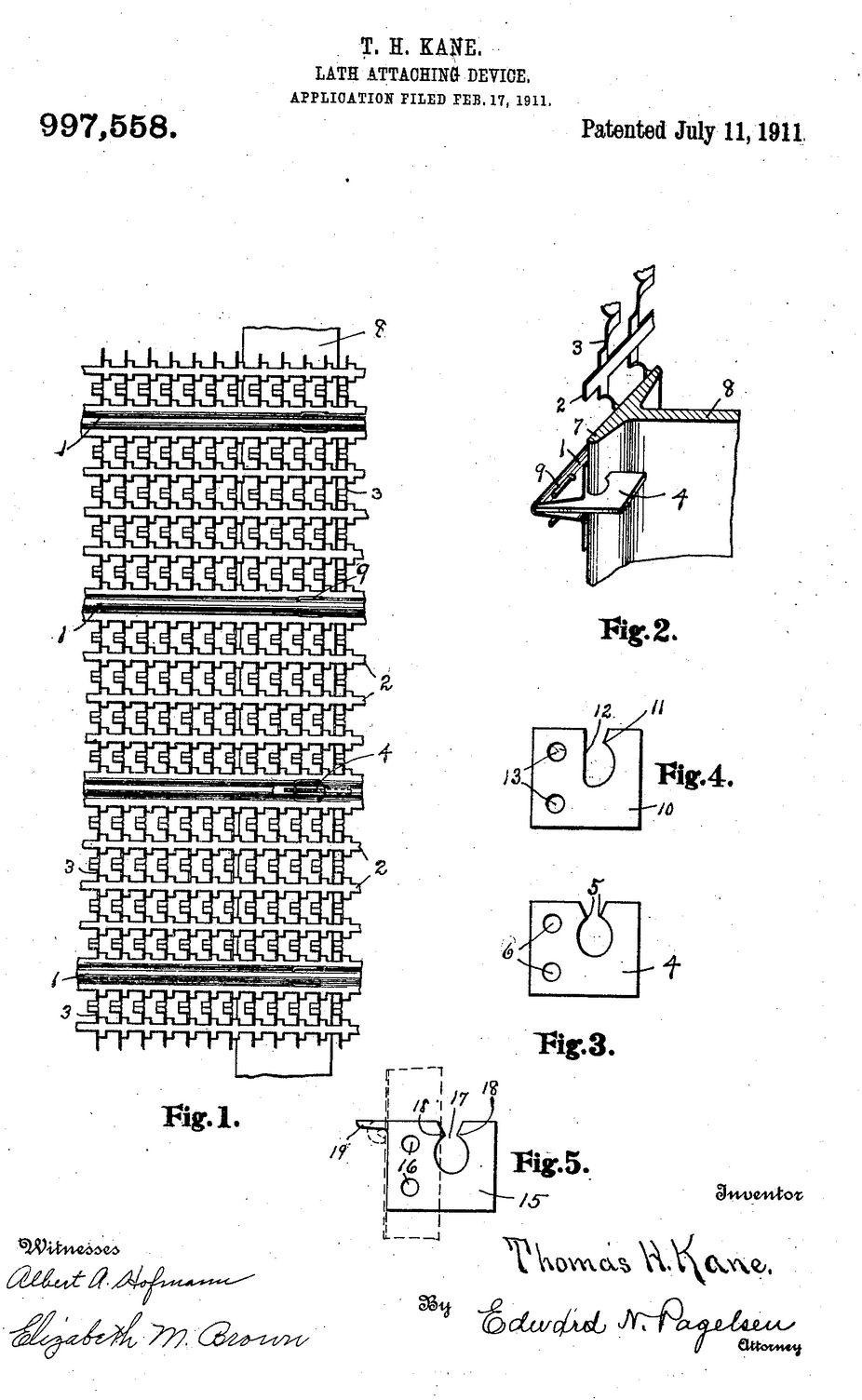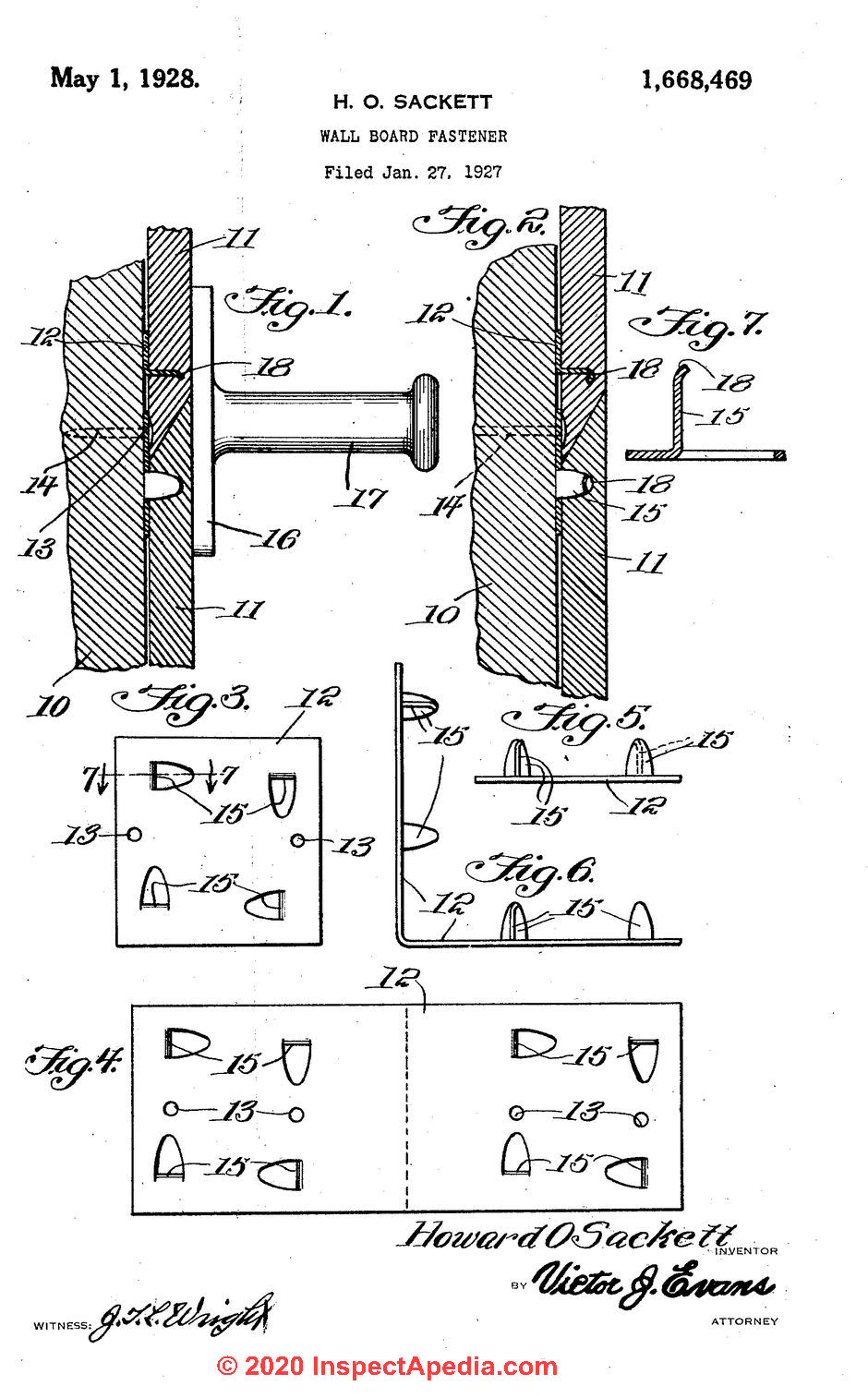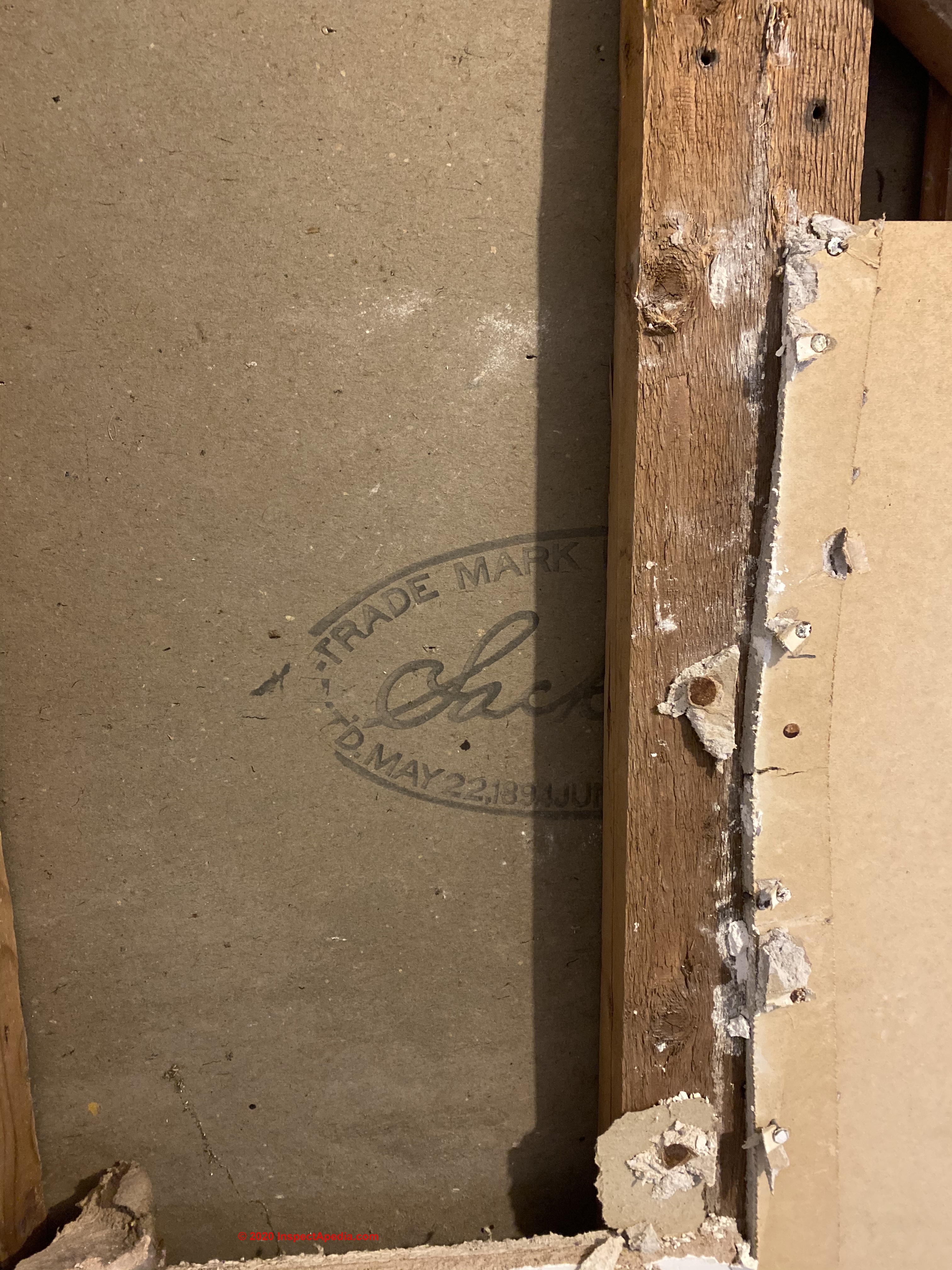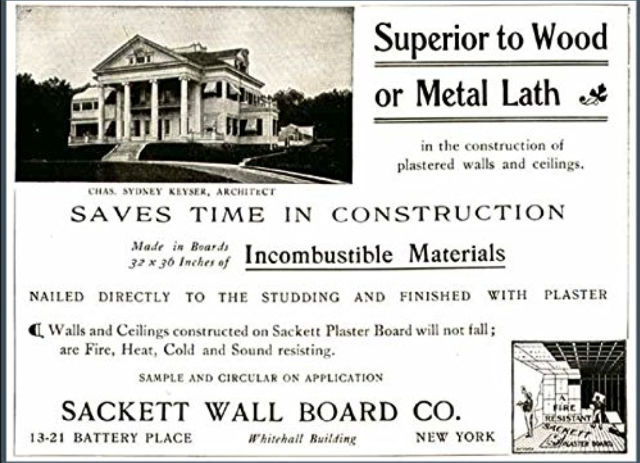 Sackett Board Plasterboard History
Sackett Board Plasterboard History
History, properties, identification of Sackett Board plaster base
- POST a QUESTION or COMMENT about history & types of interior wall & ceiling plaster installation methods
Here we describe Sackett board and give the history and properties of this, the first widely-used plasterboard - the precursor of modern drywall or "sheetrock".
In this article series we describe and discuss the identification and history of older interior building surface materials such plaster, plaster board, split wood lath, accordion lath, sawn lath, and expanded metal lath, Beaverboard, and Drywall - materials that were used to form the (usually) non-structural surface of building interior ceilings and walls.
InspectAPedia tolerates no conflicts of interest. We have no relationship with advertisers, products, or services discussed at this website.
- Daniel Friedman, Publisher/Editor/Author - See WHO ARE WE?
History of Sackett Board, multi-layered plaster & paper board - the first "drywall"
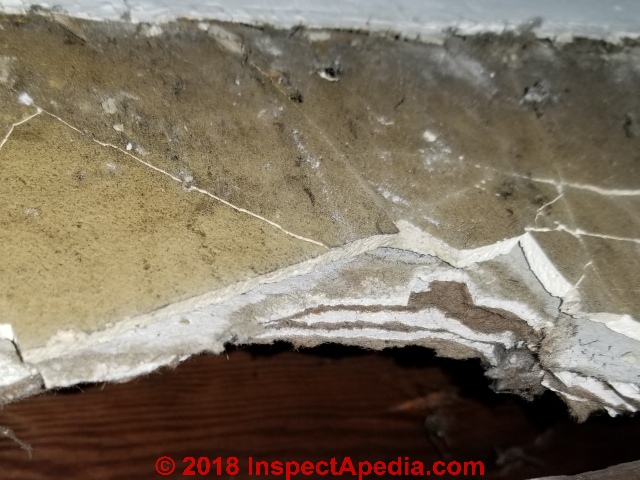 Invented in 1888 and Patented as early as 1894, Augustine Sackett's paper-coated plasterboard provided a fast, economical means of covering interior walls and began a slow shift away from reliance on wood lath for plastering systems.
Invented in 1888 and Patented as early as 1894, Augustine Sackett's paper-coated plasterboard provided a fast, economical means of covering interior walls and began a slow shift away from reliance on wood lath for plastering systems.
Sackett's earliest patent, a process for coating multiple layers of paper in rolls using tar (and straw in some forms), was granted much earlier, in 1880.
That work led to Sackett Board, the multi-layered paper and plaster board shown and discussed here. Plaster was a desirable substitute for tar and straw as it improved the board's fire-resistance, even describing it as "fireproof".
BY 1909 each Sackett Board was stamped onto each gypsum board panel as "Sackett Board".
According to US Gypsum, Sackett formed a partnership with U.S. Gypsum and later contributed a folded paper edge on these gypsum board panels - a significant step that reduced damage to the boards in shipping and handling.
Kane Friedman, (later as F.L. Kane) along with Blumenfeld and Strimban are also credited with development of plaster board as we cite below, though their patents were considerably later, granted after 1900.
The Friedman (no relation to InspectApedia.com editor Daniel Friedman) patent describes plaster board construction in the early 1900s as being made up of from eight to ten layers of paper and plaster, much like the plasterboard shown in our photo provided by InspectApedi.com reader Haniacek.
Friedman et al. patented a similar multi-layered plaster board to which a flexible metallic layer was added to permit bending to form plasterboard around a curved radius.
In at least some instances layers of paper and plaster were bonded using coal tar pitch, and included thin sheet metal reinforcement.
These plaster boards were not intended to provide a finished surface.
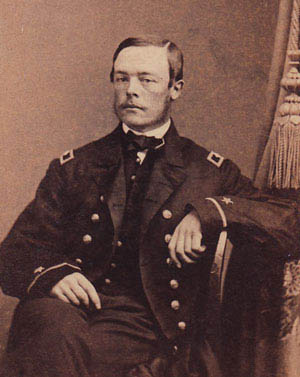 Boards-of this character should not be used to make a finished wall, a dressing or surface of ordinary plaster being relied upon for the finished surface. - Friedman 1908
Boards-of this character should not be used to make a finished wall, a dressing or surface of ordinary plaster being relied upon for the finished surface. - Friedman 1908
Sackett Board, first produced by Alexander Sackett, who formed the Sackett Plaster Board Co. became so widely-used that the term "sackett board" became rather generic, as we read in construction articles and in later patents by various inventors.
As first produced, Sackett Board was made in 32" x 36" sheets, later in larger panels.
Soon thereafter Sackett Board was marketed by US Gypsum following USG's purchase of the Sackett Plaster Board Company in 1909.
The sale of USG's Sackett Board marked USG's entry into the gypsum board or plasterboard market.
The Geneva Illinois home where this multi-layered paper and gypsum plaster board was installed is itself dated by the owner as 1907 or 1910.
We solicit photos of similar material from our readers - you can post photos and comments at the end of this page or you can use the page top or bottom CONTACT link to send us email directly.
1888: In the U.K. the first plasterboard production facility opened in 1888. In London, Gyproc Products Ltd., produced a plaster-board that included rust-resistant metal reinforcement for use as ready-made partitions.
1890-1894: In 1890 Sackett Board was invented by Augustine Sackett (his photo is provided later, below).
Other sources give 1891 but they are incorrect insofar as Sackett's U.S. Patent for his Inside Wall Covering describing this multi-layered builders paper and gypsum plaster board was filed May 23, 1890 and granted by the U.S. Patent Office No. 520,123 on May 22, 1894.
1894: Earliest Sackett Board Identifying Stamp
Below, courtesy of InspectApedia reader Luke Duke we have our earliest Sackett Board trademrk stamp from Mr. Duke's home built in 1912 in Connecticut, citing Sackett's May 22, 1984 Patent.
(Above image courtesy of LukeDuke by post to this page on 15 June 2022.)
The Sackett Wall Board company was first located in the Whitehall Building, 13-21 Battery Place, New York, NY.
To produce Sackett Board, Sackett joined forces with the Grand Rapids Plaster Company in Grand Rapids Michigan.
Sackett Board, first produced in 32 x 36" rectangles, was described as a multi-layered "wool-felt" paper and gypsum wallboard product for interior walls and ceilings.
Sackett Board was installed as a "ready-to-finish" surface to be intended to be finished with a layer of gypsum-based plaster.
Below: a multi-layered gypsum or plaster board product photo provided by reader Rob who asked if this was an asbestos product.
We discuss the photo below in a Q&A found in ASBESTOS IDENTIFICATION IN BUILDINGS FAQs.
1902: Pyrobar and Adamant Board:
In the U.S., US Gypsum was formed in 1902 by the merger of 30 independent gypsum and plaster companies.
The company's first product, Pyrobar, a gypsum-based fireproof tile, was produced in 1903.
Early versions of plasterboard produced by USG (ca 1909) were referrred to as Adamant board. But as you will read
at DRYWALL & GYPSUM BOARD COMPOSITION & HISTORY, Adamant plaster for walls and ceilings was cited at least as early as 1898.
We still find, on occasion, an Adamant identification stamp on the back of very old gypsum-board. The term "adamant plaster" is still used in current texts and refers to a cementious plaster still used to form wallboard as well as decorative plaster elements, and tiles. (Kaphle 2018)
1909 Sackett Board:
US Gypsum purchased the Sackett Plaster Board Company, (appearing as the Sackett Wall Board Co. in some advertisements) marking their entry into the gypsum board marketplace, marketing wall and ceiling panels ready to be finished with plaster.
From 1909, USG continued to market Sackett Board advertising Sackett Plaster Board as a substitute for wood lath. Early advertisements for United States Gypsum Co.'s Sackett Plaster Board cited US Gypsum, the Grand Rapids Plaster Co., and the Sackett Plaster Board Company (then owned by USG).
A useful distinction between true Sackett Board and later gypsum board,
plasterboard or Sheetrock® products is that Sackett Board and other plasterboard products of its era were usually comprised of multiple layers of paper and gypsum or plaster while later Sheetorck® and modern drywall products are usually manufactured as a single laye of plaster or gpsum covered (usually) on its front and rear face and on at least its two long edges by paper.
1912 Sackett Board Identifying Stamp
Above: courtesy of InspectApedia.com reader J.F. we see a Sackett trademark stamp on the back surface of Sackett Board plasterboard bearing three trademark registration dates beginning May 22 1894, continuing through 1912 and 1918. This Sackett board was probably manufactured after the example provided by LukeDuke, above.
1916: By 1916 USG had simplified their Sackett Board product to use a thicker gypsum-based plaster with single coatings of paper on the board exterior face and back (later also on edges), a predecessor to modern drywall.
That would place the multi-layered plaster board in the home above home as before1916.
1917 Sheetrock®:
Some sources date the first use of the term "Sheetrock" to U.S. Gypsum's product announced the following year, 1917.
Summarizing to this year, Sackett Board was produced from early in the 20th century as a plaster board or gypsum board that could be nailed to ceiling joists or wall studs as either a plaster base or later as a finished surface. US Gypsum's own history (cited below) reports that Adamant Psnel Board was re-named as a registered Sheetrock® brand sometimebefore 1920 and has remaind a US Gypsum trademark since that time.
That's why in our articles we refer to "drywall", "gypsum board" or "plasterboard" and we try to reserve use of the term "sheetrock" for a US Gypsum product Sheetrock® despite the widespread and more-generic use of that word.
1927: CertainTeed Products Co. introduced their own drywall product line, differeing from USG by leaving the gypsum interior exposed at the board edges.
1928: Howard O. Sackett, of Schenectady, NY, continued the Sackett name in drywall by patenting a plasterboard fastening device. We provide this patent in the Sackett Board research history given below.
Excerpt:
It is the purpose of the invention to obviate employment of fastening elements upon the outer surfaces of the Wall board, which frequently tend ito tear and demolish the surfaces of the boards thereby overcoming the usual necessity of plastering or coating the same precedent to painting.
Research on the History of Sackett Board & Drywall
Sackett Board identification stamp - found in renovation of 1885 home
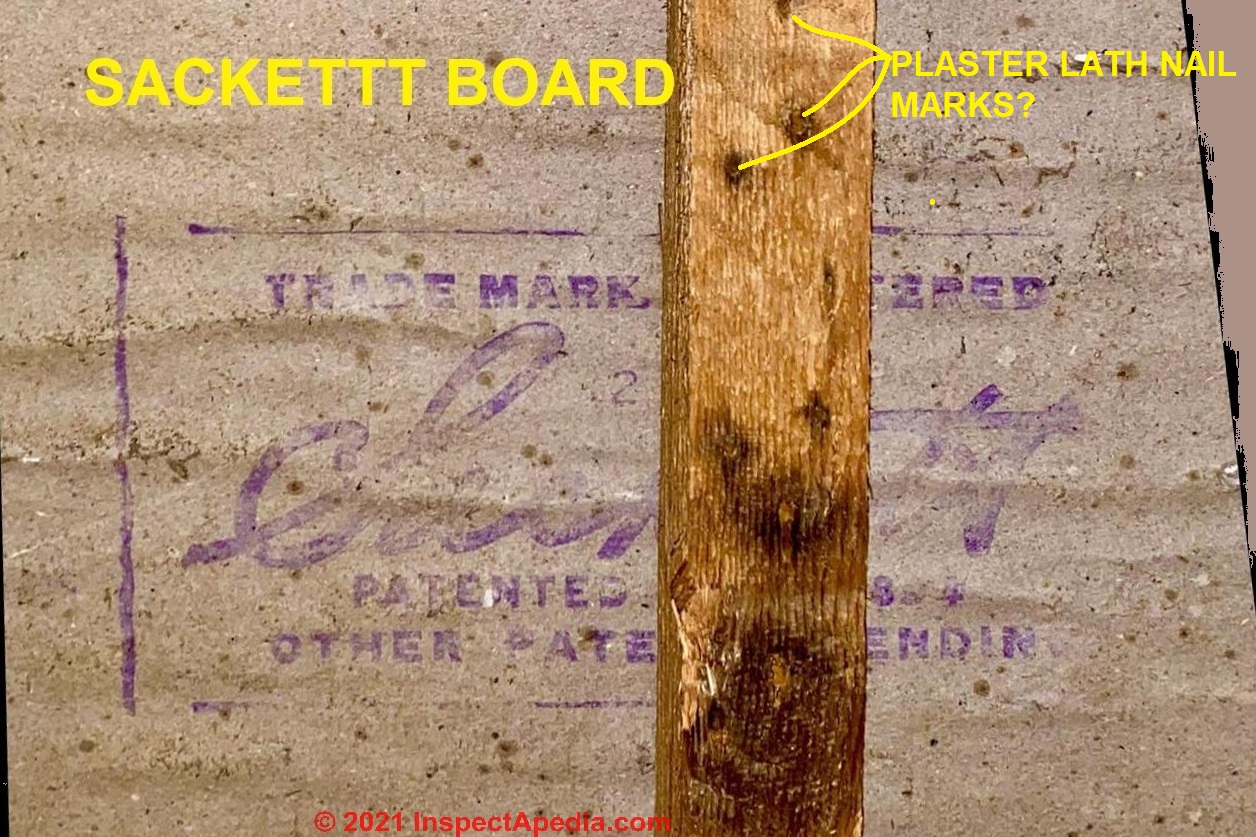 An inspectApedia reader offers this photo and comment:
An inspectApedia reader offers this photo and comment:
I just found an example of Sackett plasterboard in my 1885 home as I modernize a bathroom that my father added in 1952. It reads
“Trade Mark Registered, Sackett, Patented May 22, 1894, Other Patents Pending” - On 2021-08-02 by Russell CB -
Comment by inspectapedia.com.moderator (mod)
@Russell CB,
Thank you that's an excellent photo and will be helpful to other readers. We will be sure to keep it with your article.
Your Sackett board is an example of the first, or earliest examples of Sackett board, showing Sackett's first-known trademark stamp and citing only the May 22 1894 patent.
If your home was in fact constructed before Sackett's patent was granted, that might argue that this Sackett board was installed some years after the home's original construction.
That would be consistent with the nail marks in the xposed side of the wall stud in your photo. The number and close-spacing of those nail marks suggest that wood lath for a plaster wall was previously installed on that surface.
If you find another instance of that stamp that is not partly covered by framing, post a photo of that as well so that we can look up the exact patent number. That will add some useful historical detail.
- Kane, Frederick L. "Partition-wall construction." U.S. Patent 799,988, issued September 19, 1905.
- Friedman, Kane, Julius B. Blumenfeld, and Louis Strimban. PLASTER BOARD [PDF] U.S. Patent 912,664, issued February 16, 1909.
- Kane, Frederick L. "Plaster-support for walls." U.S. Patent 1,121,017, issued December 15, 1914.
- Kane, Thomas Henry. LATH ATTACHING DEVICE [PDF] U.S. Patent 99,558, issued July 11, 1911. Patent assigned to the Trussed Concrete Steel Company of Detroit.
Early description of what was later called "expanded metal lath" used as a plaster base. This Kane, Thomas Henry, was from Youngstown, Ohio - steel town.
Excerpt:
Ribbed metal lath of the character shown in Fig. 1 comprises a series of parallel ribs 1, formed by bending parallel in perforated strips or bands of the sheet. metal, narrow strips 2 between the ribs, and tongues 3 connecting the adjacent strips and ribs.
The clips 4 shown in Fig. 3 are sheared from sheet metal, preferably hard spring steel, and formed with teeth 5 and holes (3.
When the metal lath is positioned, these slips may be driven onto the flanges 7 of the I beams 8, or onto other proper portions of structural members,
the teeth 5 engaging the flanges so securely that the clip can be removed only by the use of considerable force.
- Sackett, Augustine, PROCESS of COATING PAPER AND CLOTH [PDF], U.S. Patent No. 226,549, May 13, 1880 retrieved 2018/09/05, original source: https://patentimages.storage.googleapis.com/6a/0e/05/5734b181139627/US226459.pdf
Excerpt:
To all whom it may concern Be it known that I, AUGUSTINE SAGKETT, of New York city, in the county of New York and State-of New York, have invented a new and useful Process for Coating Rolls of Paper on one side, preserving at the same time the reverse side free from the coating material, of which the following is a specification.
This invention is especially useful where it is desired to coat one side of the paper with a cement which cannot well be applied with brushes, either on account of its semi-fluid consistency or the necessity of applying it at a high degree of heat.
This has been done by drawing the paper under a revolving cylinder, the lower part of which cylinder is immersed in the coating material, depending upon the close contact of the surfaces of the cylinder and paper to prevent the coating material from coating both sides of the paper. It is difficult to do this effectually, and the cylinder and clean side of the paper are liable to become, to some extent, covered with the cement.
The object of my invention is to avoid this difficulty. - Sackett, Augustine, "Process for Coating Paper and Cloth", U.S. Patent No. 231,450, August 24, 1880
- Sackett, August "Roofing Felt ..." U.S. Patent No. 75,334, February 7, 1883 - possibly erroneous patent no. - Ed.
- Sackett, Augustine, "Roofing Felt and Mechanism for Making the Same", U.S. Patent No. US 291,626, January 8, 1884 / Sackett, Augustine, U.S. Patent No. 291,628, January 8, 1884
Excerpt:
Be it known that I, AUGUSTINE SACKETT, a citizen of the United States, and resident .of New York, in the county and State of New York, have invented certain new and useful Improvements in Rooting-Felt and Mechanism for making the same, of which the following is a specification, when taken in connection, with the accompanying drawings, forming a- Figure 1 is a vertical longitudinal sectional view of my machine. - Augustine Sackett, ROOFING FELT and MECHANISM for MAKING THE SAME [PDF] U.S. Patent No. 291,628, January 8, 1884 [cites and improves his January 8 1884 patent]
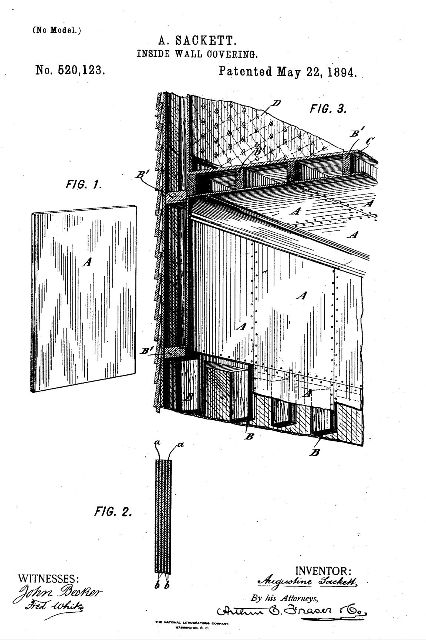
- Sackett, Augustine, INSIDE WALL COVERING [PDF], U.S. Patent No. 520,123, May, 22, 1894 - shown above [Click to enlarge any image], retrieved 2018/09/05, original source: https://patentimages.storage.googleapis.com/da/b1/d9/e909b90392f24a/US520123.pdf
Excerpt:
... I Augustine Sackett, a citizen of the United States, residing in New York city, in the county and State of New York, have invented certain new and useful Improvements in Inside Wall Coverings, of which the following is a specification.
The object of this invention is to provide boards or plates which may be used as a substitute for lath and plaster as a material for forming the inner walls of houses or rooms.
It is designed that the material may be made up in large sheets or plates of sufficient thickness to give the requisite rigidity, and of sufficient size to avoid undue frequency of joints, and that it may be manufactured and delivered in condition to be immediately fastened in place by nailing it to the studding of the walls or partitions of a house.
The invention aims to provide a material for this purpose which shall be sufficiently stiff and rigid to form a firm wall surface, sufficiently strong to resist the effect of any ordinary blows or concussions to which it may be subjected; sufficiently soft to admit of nails being driven through it, and sufficiently tough and tenacious to prevent its cracking when in place on the wall.
To these ends my invention consists of a board or plate built up of alternated webs of paper and layers of some hard adherent plastic substance in the nature of a lime cement. The substance which I have thus far found preferable is plaster of paris (calcined gypsum.)
The inherent brittleness of the plaster or other substances of this character is sufficiently overcome by applying it in thin layers alternated with webs of paper to produce, as the result of the superposition of a suitable number of such layers and webs, a board or plate of great stiff ness, strength, and rigidity and toughness in comparison with its thickness, and which in is in every way admirably adapted as a material for inside walls and surfaces.
In preparing my new board or plate I proceed preferably as follows: I select a suitable thin Manila paper, such as a fairly light Manilla wrapping paper, or preferably the quality of paper used in the manufacture of what is known as "builders' sheathing paper." This paper should be as wide as the width of the boards or plates to be made.
The plaster composition is preferably made by mixing calcined gypsum, or plaster of paris, with enough water to make it spread easily, being the consistency at which plaster of paris is usually worked.
The plaster composition being thus prepared to the proper consistency it is spread in a thin layer upon a sheet of paper, a second sheet of paper is laid upon the first, a second layer is spread upon it, and so on until as many layers have been superposed as are necessary to produce a board of the required thickness.
Ordinarily from four to eight or ten sheets of paper with their intervening layers of plaster composition will be used, the number depending on the thickness of the board desired.
- Sackett, Augustine, "PROCESS for MIXING CEMENT, PLASTER &c", [PDF] U.S. Patent No. US 624,687, May 09, 1899, retrieved 2018.09.05, original source: https://patentimages.storage.googleapis.com/ec/ac/9e/ae73d48259f982/US624687.pdf
Excerpt:
My invention relates to improvements in a process of mixing or saturating cement, plaster-of-paris, and other heavy and similar articles.
Above and below: Howard Sackett's 1928 plasterboard or "Sakett Board" fastener patent, and a photograph of plasterboard in a U.S. home, courtesy of reader J.F.
- Sackett, Howard O. WALL BOARD FASTENER [PDF] U.S. Patent 1,668,469, issued May 1, 1928.
- Sackett Family History, Augustine sackett (1841-1914) shown above, was the inventor of Sackett Board (drywall), and was inducted in 2017 into the National Inventors Hall of Fame,retrieved 2018/09/05, original source: https://www.sackettfamily.info/notables.htm
- Smithsonian, "Trade Catalogs from Sackett Wall Board Co.," fire-retardant plasterboard for walls and ceilings, gypsum board, produced by the Sackett Wall Board Co., Garbutt NY and Grand Rapids MI, Smithsonian National Museum of American History, KennethE.Behring Center, Constitution Ave NW Washington DC USA Record ID SILNMAHTL_16103.
- USG, History of US Gypsum, USG Corporation, retrieved 2018/09/05, original source: https://www.usg.com/content/usgcom/en/about-usg/company-overview/history-of-usg.html
...
...
Continue reading at DRYWALL & GYPSUM BOARD COMPOSITION & HISTORY or select a topic from the closely-related articles below, or see the complete ARTICLE INDEX.
Or see these
Recommended Articles
- ASBESTOS CEMENT CEILING & WALL PANELS
- ASBESTOS in DRYWALL
- ASBESTOS in DRYWALL MUD - TEST LOCATIONS
- ASBESTOS in DRYWALL TAPE?
- ASBESTOS in PLASTER - what about the use of asbestos in plaster walls & ceilings?
- DRYWALL, FIBERBOARD, PLASTER INTERIORS - home
- DRYWALL & GYPSUM BOARD COMPOSITION & HISTORY
- DRYWALL MANUFACTURER IDENTIFICATION STAMPS & DATE CODES
- DRYWALL TYPE IDENTIFICATION STAMPS
- GYPSUM BOARD GYP ROCK SHEATHING
- GYPSUM BOARD PLASTER LATH SYSTEMS
- PLASTER INGREDIENTS, MIX, PROPERTIES
- PLASTER TYPES & METHODS in BUILDINGS - home
Suggested citation for this web page
SACKETT BOARD at InspectApedia.com - online encyclopedia of building & environmental inspection, testing, diagnosis, repair, & problem prevention advice.
Or see this
INDEX to RELATED ARTICLES: ARTICLE INDEX to BUILDING INTERIORS
Or use the SEARCH BOX found below to Ask a Question or Search InspectApedia
Ask a Question or Search InspectApedia
Try the search box just below, or if you prefer, post a question or comment in the Comments box below and we will respond promptly.
Search the InspectApedia website
Note: appearance of your Comment below may be delayed: if your comment contains an image, photograph, web link, or text that looks to the software as if it might be a web link, your posting will appear after it has been approved by a moderator. Apologies for the delay.
Only one image can be added per comment but you can post as many comments, and therefore images, as you like.
You will not receive a notification when a response to your question has been posted.
Please bookmark this page to make it easy for you to check back for our response.
IF above you see "Comment Form is loading comments..." then COMMENT BOX - countable.ca / bawkbox.com IS NOT WORKING.
In any case you are welcome to send an email directly to us at InspectApedia.com at editor@inspectApedia.com
We'll reply to you directly. Please help us help you by noting, in your email, the URL of the InspectApedia page where you wanted to comment.
Citations & References
In addition to any citations in the article above, a full list is available on request.
- Worsham, Gibson. "Exterior Plaster Restoration at the Lord Morton House, Lexington, Kentucky." Association for Preservation Technology Bulletin. Vol. XIII, No. 4 (1981), pp. 2733
- In addition to citations & references found in this article, see the research citations given at the end of the related articles found at our suggested
CONTINUE READING or RECOMMENDED ARTICLES.
- Carson, Dunlop & Associates Ltd., 120 Carlton Street Suite 407, Toronto ON M5A 4K2. Tel: (416) 964-9415 1-800-268-7070 Email: info@carsondunlop.com. Alan Carson is a past president of ASHI, the American Society of Home Inspectors.
Thanks to Alan Carson and Bob Dunlop, for permission for InspectAPedia to use text excerpts from The HOME REFERENCE BOOK - the Encyclopedia of Homes and to use illustrations from The ILLUSTRATED HOME .
Carson Dunlop Associates provides extensive home inspection education and report writing material. In gratitude we provide links to tsome Carson Dunlop Associates products and services.


